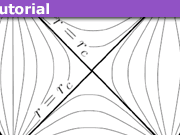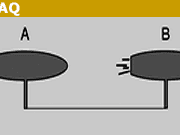Learn the Relativistic Work-Kinetic Energy Theorem
I was bothered for a long time by the reasons for the relativistic validity of the work-kinetic energy relation ##\Delta E=Fd##, which holds without any need for corrections. We’ve discussed this before here on PF, but I think at this point I understand it better, so I thought I’d post a summary of my present understanding.
Table of Contents
Einstein’s treatment
At one time I somehow got the idea that Einstein had never given any logical justification for the fact that ##\Delta E=Fd## was valid and exact relativistically. I think this was because I hadn’t carefully thought through section 10 of “On the electrodynamics…,” where he actually gives a rigorous treatment. He starts with two assumptions:
(1) We have ##ma=eE## for the motion of an electron in any instantaneously comoving frame, in an electric field E. (He explicitly uses two such frames.). There’s no way this can be subject to a correction factor such as ##\gamma##, since the electron is at rest.
(2) The electrical potential energy of an electron is given by ##eV##. This is firmly established by experiment, and it doesn’t involve motion, so there is no reasonable way that we could imagine that it would need a correction factor like ##\gamma##. In the example of a small spherical shell of charge between two capacitor plates, it’s derivable from the equation for the energy density of the field
He’s also worked out the transformations of the fields (E,B) and the coordinates, so starting from assumption 1 he’s able to find the dynamical laws in a frame where the electron is moving. He uses these dynamical laws, along with assumption 2, to find the kinetic energy of the electron at relativistic speeds.
Along the way, he also does the following. His dynamical laws give, in the parallel direction, ##eE=m\gamma^3a##, and he calls this the force (in the parallel direction), which is equivalent to the common modern definition of the three-force as ##dp/dt##. Because of assumption 2, it follows that ##\Delta E=Fd## holds exactly; he is *not* assuming ##\Delta E=Fd##, he’s proving it (for this definition of force).
Using the relativistic energy-momentum four-vector
A more modern approach is as follows. Suppose that we’ve already determined the properties of the energy-momentum four-vector. This includes the relativistic definition of mass, ##m^2=E^2-p^2##, and also the identity ##p/E=v##. Then is becomes pretty straightforward to show that ##W=Fd## is relativistically exact. Consider one-dimensional motion, and let ##p## be the momentum component along our one spatial dimension. Define ##F=dp/dt##. Then
## \frac{d E}{d x} = \frac{d E}{dp}\frac{d p}{d t} \frac{d t}{d x} = \frac{d E}{d p} \frac{F}{v} ##
By implicit differentiation of the definition of mass, we find that ##dE/dp=p/E##, and this in turn equals ##v## by the identity above. This leads to the claimed result, which is valid for both massless and material particles.
Using simple machines
I always felt that there should be some way of getting at the problem this way, but I don’t think it ends up working. Suppose we have a simple machine with mechanical advantage ##A##. At least some simple machines (such as a lever) are capable of operating rigidly (based on the definition of Born-rigidity) for arbitrary relativistic motion. (Many others are not, because rigid motion would violate the Herglotz-Noether theorem. For example, a screw undergoing accelerated motion through a set of threads at relativistic speeds would bind.) For a machine that does work relativistically, the ratio of the input and output displacements is fixed to the exact value ##1/A##, without relativistic correction.
The proportionality of work to ##F## and to ##d## follows from elementary considerations, independent of relativity. See the Feynman lectures, section I-4-2.
What seems more problematic in these arguments is the following. Suppose we have two things that could be called “force,” ##F## and ##G##, and let them differ by ##G=F h(v)##, where ##h## is some function and ##v## is the velocity of an object being acted upon. These could be, e.g., ##F=dp/dt## and ##G=dp/d\tau## (the spacelike component of the force four-vector). In this example, it turns out that the forces at the input and output of the machine are related by ##F_1/F_2=A##, while ##G_1/G_2\ne A##, but how do you show this? I don’t think you can show it without some other argument, as in the two sections above.
PhD in physics. I teach physics at Fullerton College, a community college in Southern California. I enjoy writing, playing viola, brewing beer, climbing and mountaineering.








Leave a Reply
Want to join the discussion?Feel free to contribute!